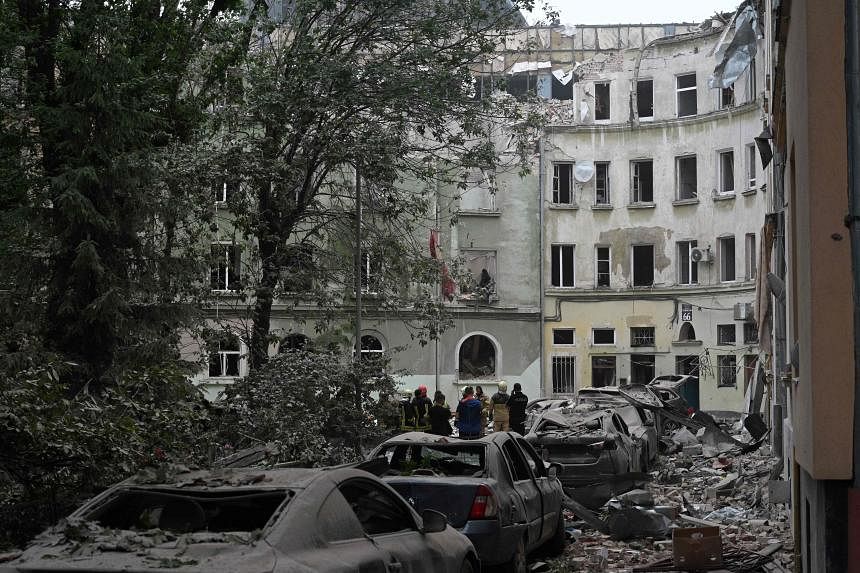KYIV - With war dragging on, some of Ukraine’s millions of refugees are beginning to think about settling for good in the countries they find themselves in across Europe, posing a challenge to rebuilding the economy when the guns finally fall silent.
Ms Natalka Korzh, 52, a TV director and mother of two, left behind a newly built dream house when she escaped the rockets falling on Kyiv in the early days of the war. She is only just finding her feet in Portugal, and does not plan on packing up her life again, even when fighting stops in Ukraine.
“Now, at 52, I have to start from scratch,” said Ms Korzh, who wants to open a charity in Portugal to help other migrants in the town of Lagoa, which she now calls home.
Studies by the United Nations refugee agency UNHCR show that the vast majority of displaced Ukrainians want to return one day, but only around one in 10 plans to do so soon.
In previous refugee crises, for example in Syria, refugees’ desire to return home faded with time, UNHCR studies show.
Reuters spoke to four company bosses who said they are now grappling with the likelihood that many refugees will not return and that the workforce will keep shrinking for years to come, a situation that is also worrying demographers and the government.
Mr Volodymyr Kostiuk, chief executive officer of Farmak, one of Ukraine’s top pharmaceutical companies, with nearly 3,000 employees and more than seven billion hryvnias (S$256 million) in revenue the year before the war, said that with so many people abroad, displaced within Ukraine or drafted into the armed forces, he was facing a shortage in qualified laboratory workers and production specialists.
“We need to somehow try to return them to Ukraine, because we already see that the longer people are abroad, the less they want to return,” said Mr Kostiuk, whose company relocated its research lab and staff to Kyiv, from close to the front line.
A poll of about 500 businesses in Ukraine carried out by Ukrainian think-tank the Institute for Economic Research and Political Studies showed that a third saw staff shortages as a key challenge.
Conscription-age men are restricted from leaving Ukraine, so working-age women and children make up the majority of refugees.
While farms and factories have lost workers to the armed forces, labour shortages are especially acute in industries requiring higher levels of education and training because educated young women are among those most likely to have left the country since the war started in February 2022.
Two-thirds of the women who sought refuge elsewhere in Europe have higher education, according to research published in March by Ukrainian think-tank the Centre for Economic Strategy.
It is not just a lack of labour, a shrinking workforce also dents consumer demand over the long term.
Fozzy Group, which operates leading supermarket chains, reopened stores in areas around Kyiv following Russia’s retreat from the region in the first few months of fighting.
But footfall is still low, said Mr Dmytro Tsygankov, a Fozzy director in charge of new product lines.
“We cannot talk about recovery when we have several million people who simply do not buy anything: They are not in the country,” said Mr Tsygankov.
He said client visits were up in May compared with 2022, but still 16 per cent below May 2021, before the invasion.
Ukraine’s population problem goes beyond millions of refugees.
A high proportion of citizens are elderly, and the country’s fertility rate, already one of the lowest in the world, is believed to have fallen to 0.7 from 0.9 since war broke out, said Ms Ella Libanova, one of the country’s most respected demographers, at the National Academy of Science.
A million people are fighting the Russians, millions more live in territory seized by Moscow or have been displaced to Russia.
The Ukrainian government does not release casualty figures, but in April, leaked United States intelligence assessments said 15,000 working-age men had been killed or wounded. Many more are injured.
Ms Libanova also warned that once wartime restrictions on men leaving the country were lifted, many could join families abroad.
“A huge risk is that men will leave,” she said. “We will lose young, qualified, enterprising, educated people. That is the problem”.
With Russia now occupying about a fifth of the country’s territory, Ms Libanova estimates the population in areas controlled by Kyiv could already be as low as 28 million, down from a government estimate of 41 million before the Feb 24, 2022 invasion.
The estimates exclude Crimea, annexed by Russia in 2014, which had around two million people at the start of that year.
Even before the war, Ukraine’s population was shrinking.
At independence in 1991, Ukraine had about 52 million people. A census in 2001 – the country’s only so far – recorded a population of 48.5 million.
Depending on how long the fighting lasts, and how many people settle abroad, Ukraine’s population is set to decline further by between about a fifth and a third over the next 30 years, according to a study published in March by the European Commission’s Joint Research Centre.
The government has not published figures for the current population, and even the best estimates allow a large margin of error to account for uncertainty about how many people are in Russia, Belarus and Russian-held territory.
Demographer Ms Libanova estimated the population at between 28 million and 34 million at the start of 2023 in parts of the country controlled by Kyiv.
The Centre for Economic Strategy estimated that between 860,000 and 2.7 million Ukrainians may remain abroad for good, based on a poll in February of more than 1,000 refugees in European Union countries.
As a result, the economy could lose 2.55 per cent – 7.71 per cent of its gross domestic product per year, it said.
Farmak CEO Kostiuk said some of his staff work remotely and that less than 5 per cent of his employees had left and stayed abroad.
But, he worries about a growing shortage of specialised workers, in part because young graduates lack practical skills after studying remotely through the pandemic and invasion.
The government is more optimistic about returnees, citing the patriotism that surged after the invasion.
Mr Oleksiy Sobolev, deputy economy minister, told a recent roundtable that he expected up to 75 per cent of refugees would head back to Ukraine within three years of the end of fighting.
Some Ukrainians overseas are supporting the economy remotely. Fashion designer Ksenia Karpenko has kept her business afloat from her current home in Tarragona on the Mediterranean coast in Spain, where she was on vacation when the war broke out.

“I was a tourist on Feb 23 and when I woke up (the next day)... I was a refugee,” Ms Karpenko told Reuters.
She had to downsize but kept going despite the war and now manages a team of eight people in Ukraine to design and make clothes sold in boutiques in Madrid and Barcelona.
“I’m more effective here rather than in Ukraine. I do more here for my compatriots as well,” she said. REUTERS

